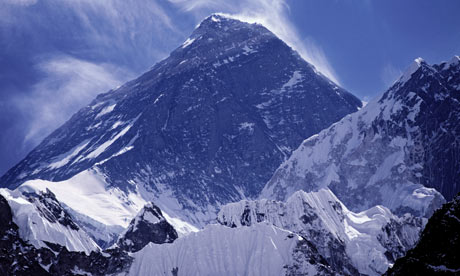Climate change may leave Mount Everest ascent ice-free, say climbers

Mission launched to measure change in Himalayas as anecdotal evidence grows of melting ice on mountain's southern approach
Climbers and custodians of Everest say that rapid climate change could soon make for an ice-free ascent of the world's tallest mountain. Their warning comes come amid a new international effort to gauge the effects of climate change in the Himalayas – and shield local people from potential hazards. A US-funded mission, led by the Mountain Institute, is meeting in Kathmandu to try to find practical solutions to the threat of catastrophic high-altitude flooding from lakes forming at the foot of melting glaciers.
Scientists acknowledge they have yet to form a complete picture of the changes under way in the high Himalayas. The task of offering a definitive scientific account of the extent of melting is daunting – and not just because the area is so vast and inaccessible. Scientists are still working to recover from a PR disaster early last year when it emerged that a United Nations report on climate change had claimed – wrongly – that the Himalayan glaciers would disappear by 2035. Rupert Murdoch's HarperCollins went through a similar exercise in humiliation when its new Times Atlas claimed up to 15% ice loss had taken place in Greenland – a finding immediately disputed by scientists as an exaggeration. But growing anecdotal evidence, from climbers and local people, suggests climate change is making a strong impact even well above the 8,000m line, with signs of melting ice on the southern approach to Everest.
"When I climbed Mount Everest last year I climbed the majority of ice without crampons because there was so much bare rock," said John All, an expert on Nepal glaciers from the University of Western Kentucky. "In the past that would have been suicide because there was so much ice." He said the terrain he crossed was very different from the landscapes described by earlier generations of climbers. Historic photographs of the Everest region also showed a longer and deeper covering of ice.
Everest Base Camp, which occupies a high rocky plateau next to the Khumbu glacier, has undergone similar changes, said Tshering Tenzing Sherpa, who has overseen rubbish collection at the site for the past few years. The summer monsoon months brought several deep new crevasses in the black ice beneath the rocks, he added. "Everything is changing with the glaciers."
The text and photo(s) in this article is taken from The Guardian. It is not allowed to be copied or interpreted without the permission of the original source, in part or as a whole, in any context or for any purpose. Please come up with your own content. We are using it for formatting purpose only. None of its content to be considered true and reliable fact or knowledge. Consider it a placeholder for text and pictures only.
The break-up of the Petermann Glacier 26-09-2011
Himalayan sherpas bugged by the sight of house flies at 5,000m 26-09-2011
Climate change may leave Mount Everest ascent ice-free, say climbers 26-09-2011
Kenya's road to recovery: Can the parks be saved? 26-09-2011
Fallout on the Fu 26-09-2011
The Gathering Storm 26-09-2011
Those Wily Russians! 26-09-2011
Everest Gets Torched 26-09-2011
Remembering Italian Mountaineer Walter Bonatti, 1930-2011 25-09-2011
Wingsuit Daredevil Jeb Corliss Will Fly Through a Mountain Cave in China 25-09-2011





